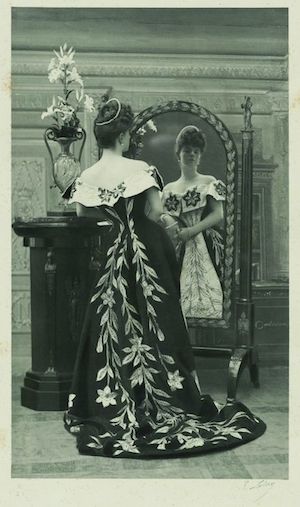Proust’s odalisque
A constellation of pearls in her hair,
Lilies curling down her velvet spine,
Grasping her waist
Like greedy hands
Releasing her hips
And melting in a pool at her feet.
A golem made of crushed madeleines and powdered meringues,
She was a figure of myth and spells
Living until the magic word written at her throat
Was erased
And she would then dissolve
Into lifeless, beautiful matter.
Standing in front of her mirror
Like a dying Narcissus
Her drowning face
Reflected a soft perfection,
A feminine despair
And a silken wit
That rippled like the muscles of a cat
And would have bit me
Should I have tried to reach out and save her.
—Published previously in Adelaide Literary Magazine (Year III, Number 17, October 2018); appears here with poet’s permission

Countess Greffulhe wearing “the Lily Dress”
created by the House of Worth, 1896
Photograph by Paul Nadar.
Galliera, musée de la Mode de la Ville de Paris.
Copyright © Nadar, Galliera, Roger-Viollet.
is a native of Los Angeles, California, who creates visual art, flash fiction, and poetry. As a writer, she speculates on the possibility of remarkable things—the secret lives of the natural world. Her writing has appeared in Adelaide Literary Magazine, Scheherazade’s Bequest, Vine Leaves Literary Journal, and other venues. She was a regular poetry contributor to Calamities Press online [now defunct], and her work was twice nominated for the Pushcart Prize.
Her visual art has appeared in magazines such as Pearl, Amelia, new renaissance, The Altadena Review, Stone Country, The Bellowing Ark, Cactus Heart Press, Written River, Typehouse, and The Sonder Review, as well as in the Pen & Ink exhibit at The Union Street Gallery in 2018. As an artist, Ms. Giordano values the architectural properties of the small things—plants and shells: subjects as vast and complex as any cityscape or countryside.
was an artist, photographer, printer, and author born in Paris, France. The son of celebrated photographer Nadar, Paul became manager of his father’s Paris studio on the Rue d’Anjou in 1874. Their rocky relationship resulted in estrangement in 1885, although the following year they collaborated on what is believed by scholars to be the first photo-interview. The son was the photographer and the father the interviewer; their subject was 101-year-old chemist and color theorist Michel-Eugène Chevreul. That same year, Paul Nadar began to experiment with photographing from a hot-air balloon and presented his results at the Société Française de la Photographie. An innovative experimenter throughout his career, he investigated artificial lighting and patented a projection system for animating still pictures; in 1893 he became Eastman Kodak’s agent in France (source: The J. Paul Getty Museum).
